Thinking of importing artificial grass but worried about the total cost? Unexpected fees can quickly turn a good deal into a bad one. I will break down all the costs for you.
A full 20GP container of artificial turf from China typically costs between $10,000 and $15,000. A larger 40HC container usually ranges from $25,000 to $40,000. These prices depend on the quality and specifications of the artificial grass you choose.
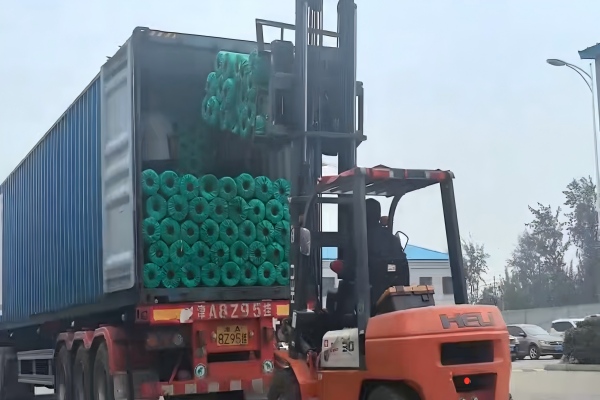
The price of a container is just the beginning. The final cost includes the product, shipping, taxes, and other fees you might not expect. Let’s look at each part of the cost. This will help you understand the complete picture. Knowing these details is the key to making a profitable deal and avoiding surprises. My goal is to give you the confidence to import directly from a factory like ours.
What Is the Wholesale Price of Artificial Grass? (A $1-$10/sq.m. Factory Guide)?
The price for artificial grass can be confusing because it varies so much. You might overpay for low-quality turf or miss a good deal. I will give you a simple factory price guide.
Wholesale artificial grass prices from China range from $1 to $10 per square meter. Budget-friendly options are typically $2-$4/sq.m. High-quality landscape or sports turf usually costs $4-6/sq.m. Premium, custom-made products can be $6-$10/sq.m.
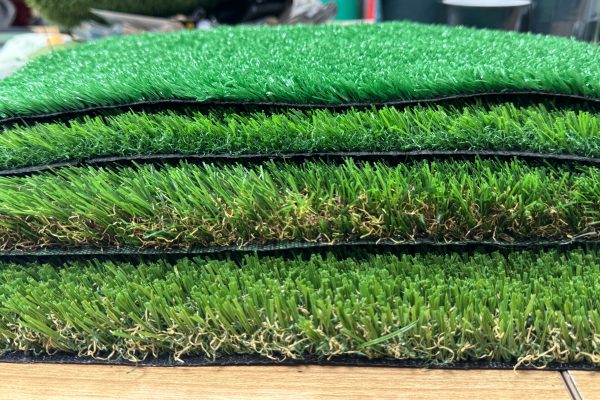
I have helped many buyers understand these prices. The cost directly relates to the materials and technical specifications of the turf. For a client like Mohammed in Saudi Arabia, who bids on big projects, choosing the right quality is crucial. A cheap product might win a bid, but it won’t last under the hot sun, and that damages a company’s reputation. It’s better to match the product quality to the project’s needs.
Key Factors Influencing Price1
The final price is not random. It depends on a few important technical details.
- Pile Height: This is how tall the grass blades are. Taller grass uses more yarn, so it costs more.
- Stitch Rate: This tells you how many stitches are in a square meter. A higher density means a fuller, more durable, and more expensive turf.
- Dtex: This measures the weight and thickness of the yarn. A higher Dtex means the yarn is stronger and more resilient, which increases the price.
- Backing: The coating on the back holds everything together. A stronger, double-layer backing is more expensive but lasts longer.
A Simple Price Guide
This table will help you understand what you get for your money.
| Price Range ($/sq.m.) | Quality Level | Typical Use | Key Features |
|---|---|---|---|
| $1 – $2 | Low-Cost / Temporary | Event flooring, decoration | Low pile height, low density, basic yarn |
| $2 – $4 | Budget-Friendly | Residential gardens, balconies | Good balance of price and quality |
| $4 – $6 | High-Quality | Commercial landscape, playgrounds | High density, durable yarn, strong backing |
| $6 – $10 | Premium / Custom | Professional sports fields | Top-spec materials, custom features, long warranty |
This guide helps you connect your project needs with the right budget.
What Are the Costs Beyond the Product Price When Importing Artificial Grass from China?
You found a great factory price for your turf. But is that the final cost you pay? Hidden fees for shipping and customs can destroy your profits. Let’s uncover all the extra costs.
Beyond the product’s factory price (FOB cost), you must budget for ocean freight2, insurance, destination port fees, customs duties, and taxes in your country. Also, remember to include inland transportation3 from the port to your final warehouse.
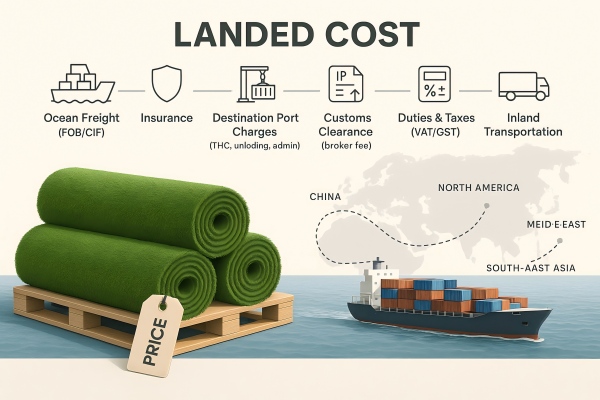
I always advise my clients to calculate the "landed cost4," not just look at the factory price. The factory price is often quoted as FOB, which means Free On Board. This price only covers the cost of the product and getting it to the Chinese shipping port. It is just the first step. After that, you have several other big expenses to think about. For my clients in the Middle East, these costs can add up, so it’s important to plan for them.
Breaking Down the "Landed Cost"
- Ocean Freight: This is the price to ship the container from a Chinese port like Tianjin to your country’s port, for example, Dammam Port in Saudi Arabia. This price changes based on the season and demand.
- Insurance: This protects your investment if the goods are lost or damaged during shipping. It is a small cost that provides great peace of mind.
- Destination Port Charges: When the ship arrives, the port charges fees for unloading the container, handling it, and temporary storage.
- Customs Clearance & Duties: You will need to hire a customs broker in your country. They handle the paperwork. You also have to pay import duties and taxes based on your government’s rules.
- Inland Transportation: Finally, you need to pay for a truck to move the container from the port to your warehouse or job site.
Understanding these costs helps you calculate your true profit margin.
What Do I Need to Know to Import Artificial Grass from China for the First Time?
Importing from China for the first time can feel risky and complex. Mistakes in paperwork or choosing the wrong supplier can cause delays and cost you money. I will share an essential checklist for first-time importers.
First-time importers must find a reliable supplier, get detailed product specifications, and agree on clear payment and shipping terms. You should also understand your country’s import regulations, hire a customs broker, and arrange a quality inspection before shipment.
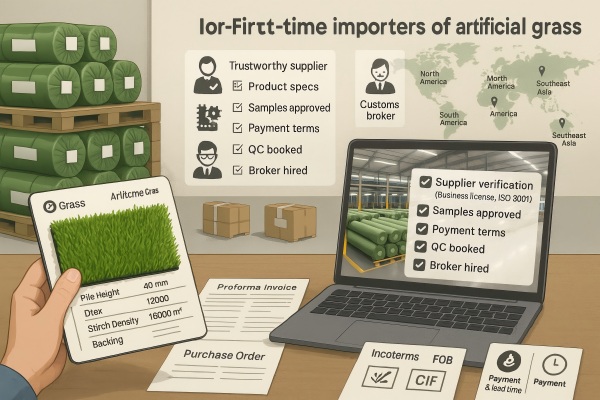
I remember working with a new buyer from Riyadh. He was a confident business owner but was new to importing. He was worried about making a mistake. This is a normal feeling. You can protect yourself with a clear plan. The most important thing is to do your research before you send any money. This preparation makes the whole process much smoother and safer.
Your Pre-Order Checklist
- Supplier Verification5: Check the supplier carefully. Ask for their business license, factory photos, and quality certificates like ISO 9001. A good supplier will be happy to provide this information.
- Product Samples: Never order a full container before you see and approve a physical sample. Check the quality of the yarn, the strength of the backing, and the overall look and feel.
- Clear Proforma Invoice6 (PI): Your order document should list everything. This includes detailed product specs, price per unit, total quantity, payment terms (like 30% deposit, 70% balance), and shipping terms (like FOB or CIF).
- Find Local Help: You will need a freight forwarder and a customs broker in your own country. Find them early. They will help you manage shipping, paperwork, and customs.
Why Quality Control7 is Non-Negotiable
For a business owner like Mohammed, quality is everything. One bad batch of turf can ruin a project and a reputation. I always recommend a third-party inspection before the container leaves the factory. For a few hundred dollars, an inspector can check the goods and send you a full report with photos. This small cost can save you thousands of dollars and many problems later.
What is the Full Import Process for Artificial Turf, from a Chinese Factory to Your Warehouse?
You have placed your order. Now, how does the artificial grass get from the factory to you? The journey has many steps and requires many documents. One missing paper can get your container stuck at customs.
The process starts with production and quality inspection. Then, your goods are trucked to a port in China and cleared for export. After sailing across the ocean, the container arrives, goes through import customs clearance8, and is finally delivered to your warehouse.
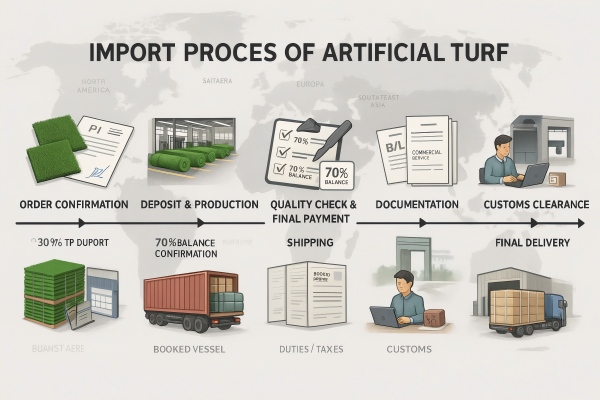
Many people focus only on the price and product. They forget about the logistics. The journey of your container is a long chain of events. Understanding this process helps you track your shipment and prepare for its arrival. It’s the best way to avoid delays, which is very important for project timelines. If your turf arrives late, it can delay an entire construction project.
The A-to-Z Import Timeline
Here is a simple breakdown of the journey your artificial grass will take.
| Step | What Happens | Key Documents/Actions |
|---|---|---|
| 1. Order & Production | You confirm the order and pay the deposit. The factory starts production. | Proforma Invoice (PI), T/T deposit slip |
| 2. Pre-Shipment | Production ends. A quality inspection happens. You pay the balance amount. | Inspection Report, Commercial Invoice, Packing List |
| 3. Export Logistics | We book a space on a ship, truck the container to the port, and clear China customs. | Bill of Lading (B/L), Customs Declaration |
| 4. Ocean Transit | The container is on the ship, sailing to your country. | Vessel tracking number |
| 5. Import & Delivery | The ship arrives. Your local customs broker clears the goods through customs. | Original B/L, Customs Entry, Duty Payment Receipt |
At QH Grass, we help our partners manage this whole process. We provide all the correct documents on time and keep you updated at every stage. Our mission is to make importing feel as easy as buying locally. This lets you focus on your business, not on logistics problems.
Conclusion
Importing grass involves understanding product prices and total landed costs. A clear process and a reliable partner are the most important things for ensuring your success and profitability.
-
Understanding these factors can help you make informed decisions and avoid overpaying for turf. ↩
-
Exploring ocean freight costs can help you anticipate shipping expenses and avoid surprises. ↩
-
Understanding inland transportation costs is essential for budgeting the total expenses of your import. ↩
-
Understanding landed cost is crucial for accurate budgeting and profit calculation when importing. ↩
-
Understanding supplier verification is crucial to avoid scams and ensure quality products. ↩
-
A clear proforma invoice is essential for smooth transactions and avoiding misunderstandings. ↩
-
Quality control can save you from costly mistakes and ensure your products meet standards. ↩
-
Learning about customs clearance can help you navigate potential delays and ensure a smooth import process. ↩
_画板-1.png)
_画板-1.png)